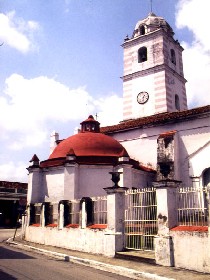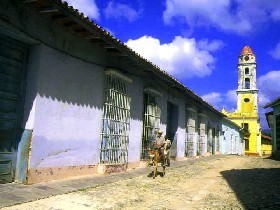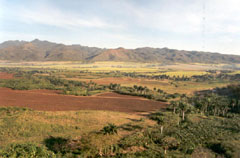|
BRIDGE OVER THE YAYABO RIVER
The Yayabo Bridge (Puente Yayabo), which rises up over the city of Sancti Spíritus, is the only one of its type in Cuba and one of the most ancient in the country. It was built from bricks, lime and sand from the surrounding area, without using cement, according to one technical report from the laboratory of the National Centre of Conservation, Restoration and Museums.
Maribí Cabrera, an engineer from the Centre of Patrimony in this Cuban province, in declarations to Prensa Latina commented that the study, carried out with different samples, contradicted the theory of the use of cement brought all the way from Italy, which supposedly influenced the strength of the building, now a National Monument, that is still standing today.
Cabrera and Anai Gómez, two specialists that requested the investigation, said that the confusion came from the use of the term “roman cement", which was used during this period to refer to a mixture of lime, sand and puzzolana (volcanic rocks, bricks, tiles or other ceramic materials) which were pulverised by mechanical means, for use as a construction material.
Another fact which confirms this theory is that cement was patented in 1844, much later than the final construction of the bridge between the two shores. The specialists have explained that its resistance is due to the use of local materials and not imported ones from Europe.
The Capitulary Acts (Actas Capitulares) and other documents of the colonial period which were examined, contain even yet another surprise, the construction of the Yayabo bridge was carried out by prisoners of the area and not by slaves, as had originally been thought.
For more information:
www.cuba-architecture.com
,
www.cuba-history.com
,
www.cuba-sanctispiritus.com
|
|
|
CABALLETE DE CASA
Caballete de Casa, among the Escambray mountains, in the centre of the island, was the site chosen by the Comandante Guerrillero (Ernesto Che Guevara) for establishing his headquarters.
Ernesto Che Guevara’s Headquarters (Comandancia de Ernesto Che Guevara) during the struggle before 1959, located in Caballete de Casa, in the mountain massif of the Escambray, in the centre of the country, is currently being restored.
According to the National Agency of Information (Agencia de Información Nacional), the work being carried out reproduces exactly the legendary facilities used by the heroic warrior of Argentine-Cuban descent, as a training school for the Number Eight Column of the Rebel Army (Ejercito Rebelde), before 1959.
The ensemble, declared a National Monument 20 years ago, has a structure of rustic wooden props, covered by palm leaves.
Caballete de Casa, some 440 kilometres southeast of Havana, is the highest elevation of Fomento’s geography, in the province of Sancti Spíritus, 764 metres above sea level.
For more information:
www.cuba-che.com
,
www.cuba-escambray.com
,
www.cuba-heroes.com
,
www.cuba-history.com
,
www.cuba-sanctispiritus.com
|
|
|
MANACAS IZNAGA TOWER
Today one can still admire as a vestige of the ancient grandeur of the surrounding area of Trinidad, the elegant bell tower of the Manacas-Iznaga sugar mill, declared together with the city of Trinidad, a National Monument.
One can also see the house of the ancient Bella Vista sugar mill, built in the fourth decade of the nineteenth century by the wealthy Don Pedro Malibrán, in the most severe roman style.
Also outstanding due to its authentic native style, is the house of the Guáimaro sugar mill, one of the most productive of that period. Among the remains of the Manacas-Iznaga “batey”, there are some “bohíos” from a settlement of slaves, considered among the largest in 1857.
The colourful vegetation of the Valley of the Sugar Mills (Valle de los Ingenios) surrounds these remains of Cuban past with their own magic. The tableau is completed with the Manacas-Iznaga tower, built in 1816.
For more information:
www.cuba-history.com
,
www.cuba-sugar.com
,
www.cuba-sanctispiritus.com
|
|
|
REMAINS OF THE TRAIL (TROCHA) FROM JÚCARO TO MORÓN
A brief history of the Trail (Trocha) from Júcaro to Morón.
In the wars of 1868 and 1895, the Trocha was an insurmountable barrier, as the Spanish thought, and after it was finished, it became the most perfect and sophisticated military construction that the Spanish Colonialism had in America. Of course it was never a deterrent for the glorious Mambi Army (Ejército Mambí), who in both wars kept crossing it ,showing the ingenious strategies deployed by their military chiefs, among them Máximo Gómez and Antonio Maceo, with the help of other insurrectional chiefs of the area, such as Brigadier José Gómez Cardoso and Colonel Simón Reyes Hernández, known as the Eagle of the Trocha (El Águila de la Trocha).
The aim of this military line was to isolate the mambi forces in the eastern area, in order to deter help and break contact between the insurrectional forces in the central and eastern regions, and to stop the invaders, led by Máximo Gómez and Antonio Maceo from extending the war to the western region of the country, an event that would wear down the strength of Spanish colonialism, leading up to its final fall.
By the end of March of 1871, three years from the Cry of Yara (Grito de Yara), General Blas Villate de la Hera, Count of Valmaseda, proposed to the Overseas Minister of the Spanish Crown; the construction of a trocha or fortified line, from the port of Júcaro, on the southern coast; running across the island, to the settlement of Morón, on the northern coast.
Valmaseda’s proposal was approved, and construction on the trocha was started. It started out with 17 fortresses and in 1874, 16 bunkers had been added on, more than five thousand men were employed to guard it, these soldiers had modern infantry weapons as well as ten pieces of artillery, which were moved along the Trocha by a narrow railway, which also allowed them to quickly move the troops from one end to the other.
For more information:
www.cuba-heroes.com
,
www.cuba-history.com
,
www.cuba-matanzas.com
,
www.cuba-cienfuegos.com
,
www.cuba-villaclara.com
,
www.cuba-sanctispiritus.com
|
|
|
SANCTI SPIRITUS
 Sancti Spiritus is a province where there are many tourist attractions, among them the Villa of the Holy Trinity (Villa de la Santísima Trinidad), some 67 kilometres from the Villa del Espíritu Santo, capital of the province of Sancti Spíritus.
It was founded in 1514 and is among the first seven cities established by the Spanish on the island.
Among the places to visit are the Church (Iglesia Mayor), Main Theatre (Teatro Principal) and the Bridge over the Yayabo river (Puente sobre el Río Yayabo).
This last was intended for the crossing over of carriages and wheelbarrows and in the present still conserves its ancient slenderness. Many people catalogue it as an open-air museum.
The baroque Spanish style can be appreciated in a good part of its mansions and in the classical design of the Church (Iglesia Mayor), together with its plaza, which evolved into constructions more adapted to the country’s climate.
Sancti Spiritus is a province where there are many tourist attractions, among them the Villa of the Holy Trinity (Villa de la Santísima Trinidad), some 67 kilometres from the Villa del Espíritu Santo, capital of the province of Sancti Spíritus.
It was founded in 1514 and is among the first seven cities established by the Spanish on the island.
Among the places to visit are the Church (Iglesia Mayor), Main Theatre (Teatro Principal) and the Bridge over the Yayabo river (Puente sobre el Río Yayabo).
This last was intended for the crossing over of carriages and wheelbarrows and in the present still conserves its ancient slenderness. Many people catalogue it as an open-air museum.
The baroque Spanish style can be appreciated in a good part of its mansions and in the classical design of the Church (Iglesia Mayor), together with its plaza, which evolved into constructions more adapted to the country’s climate.
For more information:
www.cuba-escambray.com
,
www.cuba-trinidad.com
,
www.cuba-sanctispiritus.com
|
|
|
TRINIDAD
 The Villa of Trinidad, the third founded in the country, was originally located along the shores of the Tuinucú River, and later moved to the shores of the Yayabo River in 1552. It features many cultural and architectural values, as well as beautiful landscapes that form harmonic scenery enjoyed by many visitors.
Declared a Heritage of Humanity by UNESCO in December of 1998 it invites one to tour its stoned streets and discover each historical event of the villa, jealously preserved by its dwellers.
The sugar industry and its splendour also tell the story of the Villa’s history, with the San Luis Valley or Sugar Mill Valley (Valle de San Luis o Valle de los Ingenios), that is now an important archaeological reserve.
The Villa of Trinidad, the third founded in the country, was originally located along the shores of the Tuinucú River, and later moved to the shores of the Yayabo River in 1552. It features many cultural and architectural values, as well as beautiful landscapes that form harmonic scenery enjoyed by many visitors.
Declared a Heritage of Humanity by UNESCO in December of 1998 it invites one to tour its stoned streets and discover each historical event of the villa, jealously preserved by its dwellers.
The sugar industry and its splendour also tell the story of the Villa’s history, with the San Luis Valley or Sugar Mill Valley (Valle de San Luis o Valle de los Ingenios), that is now an important archaeological reserve.
For more information:
www.cuba-escambray.com
,
www.cuba-trinidad.com
,
www.cuba-sanctispiritus.com
|
|
|
VALLEY OF THE SUGAR MILLS (VALLE DE LOS INGENIOS)
 Located near the legendary city of Trinidad, with its 277 square kilometres of land, is this wonderful work of nature in the mountain massif of the Escambray, in the province of Sancti Spiritus. The UNESCO named the Valley as a Heritage of Humanity in 1988. In it are located a total of 77 archaeological sites of what was the birth of the Cuban sugar industry during the Spanish colonization.
There are eleven farmsteads, some of them totally reconstructed, others are considered ruins, three constructive remains of sugar mills, machinery and other useful factory tools, as well as a settlement where slaves lived. Warehouses and two bell towers complete the vernacular architecture in the three rural settlements.
Located near the legendary city of Trinidad, with its 277 square kilometres of land, is this wonderful work of nature in the mountain massif of the Escambray, in the province of Sancti Spiritus. The UNESCO named the Valley as a Heritage of Humanity in 1988. In it are located a total of 77 archaeological sites of what was the birth of the Cuban sugar industry during the Spanish colonization.
There are eleven farmsteads, some of them totally reconstructed, others are considered ruins, three constructive remains of sugar mills, machinery and other useful factory tools, as well as a settlement where slaves lived. Warehouses and two bell towers complete the vernacular architecture in the three rural settlements.
For more information:
www.cuba-history.com
,
www.cuba-sanctispiritus.com
|
|
 Sancti Spiritus is a province where there are many tourist attractions, among them the Villa of the Holy Trinity (Villa de la Santísima Trinidad), some 67 kilometres from the Villa del Espíritu Santo, capital of the province of Sancti Spíritus.
It was founded in 1514 and is among the first seven cities established by the Spanish on the island.
Among the places to visit are the Church (Iglesia Mayor), Main Theatre (Teatro Principal) and the Bridge over the Yayabo river (Puente sobre el Río Yayabo).
This last was intended for the crossing over of carriages and wheelbarrows and in the present still conserves its ancient slenderness. Many people catalogue it as an open-air museum.
The baroque Spanish style can be appreciated in a good part of its mansions and in the classical design of the Church (Iglesia Mayor), together with its plaza, which evolved into constructions more adapted to the country’s climate.
Sancti Spiritus is a province where there are many tourist attractions, among them the Villa of the Holy Trinity (Villa de la Santísima Trinidad), some 67 kilometres from the Villa del Espíritu Santo, capital of the province of Sancti Spíritus.
It was founded in 1514 and is among the first seven cities established by the Spanish on the island.
Among the places to visit are the Church (Iglesia Mayor), Main Theatre (Teatro Principal) and the Bridge over the Yayabo river (Puente sobre el Río Yayabo).
This last was intended for the crossing over of carriages and wheelbarrows and in the present still conserves its ancient slenderness. Many people catalogue it as an open-air museum.
The baroque Spanish style can be appreciated in a good part of its mansions and in the classical design of the Church (Iglesia Mayor), together with its plaza, which evolved into constructions more adapted to the country’s climate.
 The Villa of Trinidad, the third founded in the country, was originally located along the shores of the Tuinucú River, and later moved to the shores of the Yayabo River in 1552. It features many cultural and architectural values, as well as beautiful landscapes that form harmonic scenery enjoyed by many visitors.
Declared a Heritage of Humanity by UNESCO in December of 1998 it invites one to tour its stoned streets and discover each historical event of the villa, jealously preserved by its dwellers.
The sugar industry and its splendour also tell the story of the Villa’s history, with the San Luis Valley or Sugar Mill Valley (Valle de San Luis o Valle de los Ingenios), that is now an important archaeological reserve.
The Villa of Trinidad, the third founded in the country, was originally located along the shores of the Tuinucú River, and later moved to the shores of the Yayabo River in 1552. It features many cultural and architectural values, as well as beautiful landscapes that form harmonic scenery enjoyed by many visitors.
Declared a Heritage of Humanity by UNESCO in December of 1998 it invites one to tour its stoned streets and discover each historical event of the villa, jealously preserved by its dwellers.
The sugar industry and its splendour also tell the story of the Villa’s history, with the San Luis Valley or Sugar Mill Valley (Valle de San Luis o Valle de los Ingenios), that is now an important archaeological reserve.
 Located near the legendary city of Trinidad, with its 277 square kilometres of land, is this wonderful work of nature in the mountain massif of the Escambray, in the province of Sancti Spiritus. The UNESCO named the Valley as a Heritage of Humanity in 1988. In it are located a total of 77 archaeological sites of what was the birth of the Cuban sugar industry during the Spanish colonization.
There are eleven farmsteads, some of them totally reconstructed, others are considered ruins, three constructive remains of sugar mills, machinery and other useful factory tools, as well as a settlement where slaves lived. Warehouses and two bell towers complete the vernacular architecture in the three rural settlements.
Located near the legendary city of Trinidad, with its 277 square kilometres of land, is this wonderful work of nature in the mountain massif of the Escambray, in the province of Sancti Spiritus. The UNESCO named the Valley as a Heritage of Humanity in 1988. In it are located a total of 77 archaeological sites of what was the birth of the Cuban sugar industry during the Spanish colonization.
There are eleven farmsteads, some of them totally reconstructed, others are considered ruins, three constructive remains of sugar mills, machinery and other useful factory tools, as well as a settlement where slaves lived. Warehouses and two bell towers complete the vernacular architecture in the three rural settlements.